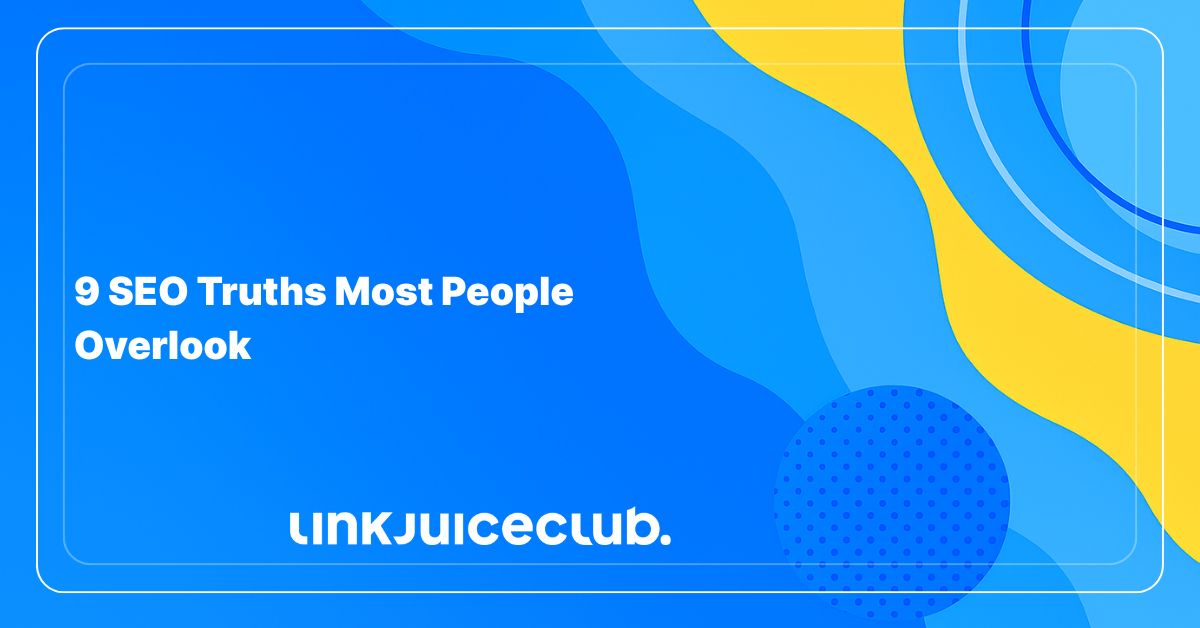
9 SEO Truths Most People Overlook
Search engine optimization is one of the most powerful channels for digital growth, yet it remains clouded by myths and half-truths. Google’s constant algorithm changes, the rise of AI-driven search, and an endless stream of “SEO hacks” make it harder than ever to separate fact from fiction.
Many brands think success is about publishing content and waiting for results. Others believe SEO is only about keywords and backlinks. The reality is more complex. Ranking well takes planning, technical precision, and long-term consistency.
This article highlights nine misunderstood truths about SEO in 2025 — the kind of insights that help teams focus on what actually drives visibility and growth.
Big Brands Dominate Big Keywords
When it comes to competitive, high-volume terms, Google gives preference to authority. Type “men’s jeans” into search and you’ll see Macy’s, Levi’s, and Nordstrom holding the top spots. Smaller sites rarely replace these giants because Google knows users trust established brands.

This doesn’t mean new players can’t compete. The key is narrowing your scope. Instead of aiming for broad, crowded terms, target niche keywords such as “slim fit dark wash jeans” or “organic cotton men’s jeans.” These long-tail searches carry less competition but higher intent.
Paid ads can also supplement organic efforts, though costs rise quickly in competitive markets. Building recognition around your own brand name is another proven strategy. Over time, if customers search directly for you, it sends positive signals to Google that boost credibility.
Pages, Not Sites, Win Rankings
A common misconception is that Google ranks entire websites. In truth, rankings happen at the page level. Each page competes for visibility based on its own quality, relevance, and optimization.
This distinction matters because not all parts of your site carry equal weight. Product categories, blog posts, and detailed guides are more likely to rank than a contact form or terms page. For example, Levi’s has sections for men, women, and kids. Each serves a different audience and has its own chance to appear in search results.
Effective SEO means focusing on high-value pages and optimizing them for specific intents. Building supporting content that links internally helps reinforce authority, creating clusters of pages that strengthen each other.
A Few Keywords Can Drive Real Growth
Many people think SEO success requires hundreds of keywords ranking in the top three spots. In reality, a handful of targeted terms can generate the majority of results.
If your business serves a narrow niche, even two or three keywords can deliver meaningful revenue. For example, a company selling “DISC profile assessments” may earn most of its leads from just that core phrase and a few variations.
This doesn’t mean ignoring broader terms. It means understanding which searches actually move the needle. With clear data and tracking, you can identify the keywords with the highest commercial intent and double down on those.
Content Marketing Is Fiercely Competitive
“Content is king” has been true for years, but today it’s also crowded. Every competitor is publishing blogs, guides, and resources. Standing out requires more than showing up — it requires excellence.
Investing in keyword research, professional writers, and updated strategies is essential. Tools like BuzzSumo can help you track which content performs best in your niche, while Moz Content can reveal competitor strategies. These insights help you identify gaps and opportunities.
To win, you must create content that is not just relevant but better than what already ranks. Strong headlines, visual assets, and consistent updates all help you cut through the noise.
Early Adopters Get Ahead
Google regularly introduces new technologies that change how results are delivered. Brands that adopt these tools early often gain an advantage before competitors catch on.
Accelerated Mobile Pages (AMP) gave fast adopters priority in mobile carousels. HTTPS adoption offered a ranking boost when it became standard. Today, structured data, AI content integration, and voice search optimization are areas where early movers benefit.
The lesson is simple: pay attention to new developments and act quickly. Early adoption often signals authority and adaptability, both of which Google values when ranking content.
SEO Isn’t Bound by Borders
Search optimization doesn’t stop at national borders. If your product or service has international potential, global SEO strategies open new growth opportunities.
Tactics include using local domains like .de for Germany or .fr for France, creating dedicated subdirectories for each region, and translating content for cultural accuracy. Hosting content in the target market can also improve relevance.
Global SEO goes beyond translation. It requires localization — adapting messaging, keywords, and tone to reflect how people in each region actually search. Brands that invest in this approach build trust and visibility across multiple markets.
Visibility Extends Beyond Blue Links
Search results today look very different from a decade ago. Standard organic listings remain important, but they’re no longer the only way to attract clicks. Google’s results pages now feature Knowledge Panels, featured snippets, image packs, and video carousels — each offering its own path to visibility. Brands that show up across these features gain more real estate and more trust.
Rich snippets, powered by structured data, are one of the easiest entry points. By tagging your content correctly, you can surface star ratings, FAQs, pricing, or availability details directly in the search result. This makes a listing stand out, often increasing click-through rates even when the ranking itself hasn’t changed. Similarly, “People also ask” boxes create extra chances for exposure if your content answers common user questions.
For local businesses, the local three-pack is critical. Appearing in the map listings with reviews, photos, and contact information drives immediate action from searchers. Optimizing your Google Business Profile, keeping reviews fresh, and ensuring NAP (name, address, phone number) consistency across directories can be the difference between invisibility and foot traffic.
In short, visibility in search is no longer one-dimensional. Businesses that diversify their presence across multiple SERP features capture more attention and insulate themselves against fluctuations in traditional rankings.
SEO Has Many Specialties
Search optimization is not a single discipline — it’s an ecosystem of specialized skills. Technical SEO ensures a site can be crawled, indexed, and loaded efficiently. Without it, even the best content won’t rank. Content SEO, on the other hand, focuses on building relevance and authority through high-quality writing, keyword strategy, and topical depth.
Local SEO focuses on signals like directory listings, map packs, and customer reviews to help businesses reach nearby audiences. International SEO takes it a step further, requiring localization, hreflang tags, and cultural adaptation. Each area demands distinct tools and methods, ranging from schema markup and competitor analysis to translation workflows and detailed site audits.
Because of this variety, no single person can realistically master every aspect at an expert level. Many businesses build cross-functional SEO teams where technical, content, and outreach specialists collaborate.
Others hire agencies that cover all disciplines under one roof. Success comes from knowing which expertise aligns with your business goals and investing in the right mix, not trying to apply a one-size-fits-all approach.
Google Isn’t the Only Search Engine
Google may dominate the search market, but it’s not the only platform where people search for answers, products, or ideas. Microsoft’s Bing, for example, still holds meaningful market share and has grown steadily thanks to its integration with Windows and AI-powered tools like Copilot. In some B2B and professional markets, Bing traffic even converts better than Google.

YouTube is another giant in the search world. As the second-largest search engine, it’s the go-to platform for tutorials, product research, and entertainment.
Optimizing for YouTube search with titles, tags, and descriptions can drive brand discovery in ways that text-based content can’t. With video increasingly showing up in Google’s blended results, YouTube SEO doubles as a visibility play in traditional search.
Amazon has also become a dominant search engine, but for products. Nearly half of consumers now begin their shopping journey there. Optimizing product titles, descriptions, and reviews for Amazon’s A9 algorithm is just as critical for e-commerce brands as ranking in Google. Ignoring Amazon means missing high-intent buyers ready to convert.
A modern SEO strategy looks beyond Google alone. Whether it’s Bing, YouTube, Amazon, or even niche engines like DuckDuckGo, the priority is aligning efforts with where your audience actually searches. Brands that broaden their reach capture more traffic and avoid over-reliance on a single platform.
SEO Success Requires Realistic Perspective
SEO is powerful but often misunderstood. Big brands dominate broad terms, but smaller companies can thrive with focused strategies. Content marketing remains essential but must be exceptional to break through. Global markets, emerging technologies, and diverse platforms all expand what SEO means today.
The takeaway? Don’t chase shortcuts or myths. Focus on building authority, understanding search intent, and delivering consistent value. Businesses that embrace these truths position themselves not just to rank, but to grow sustainably.





